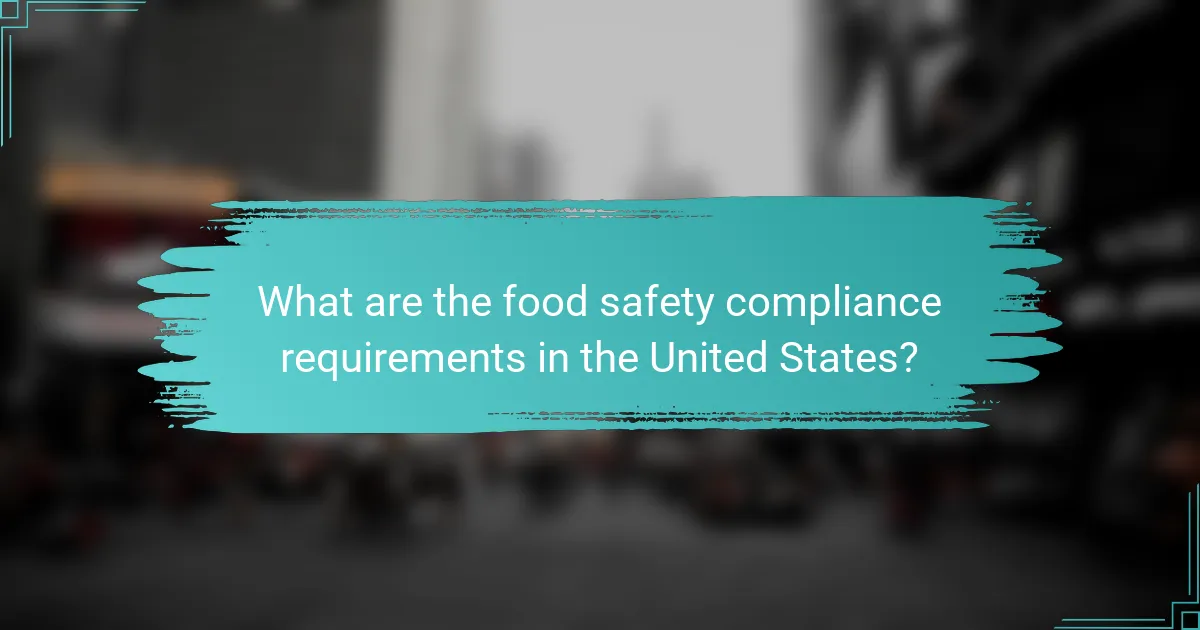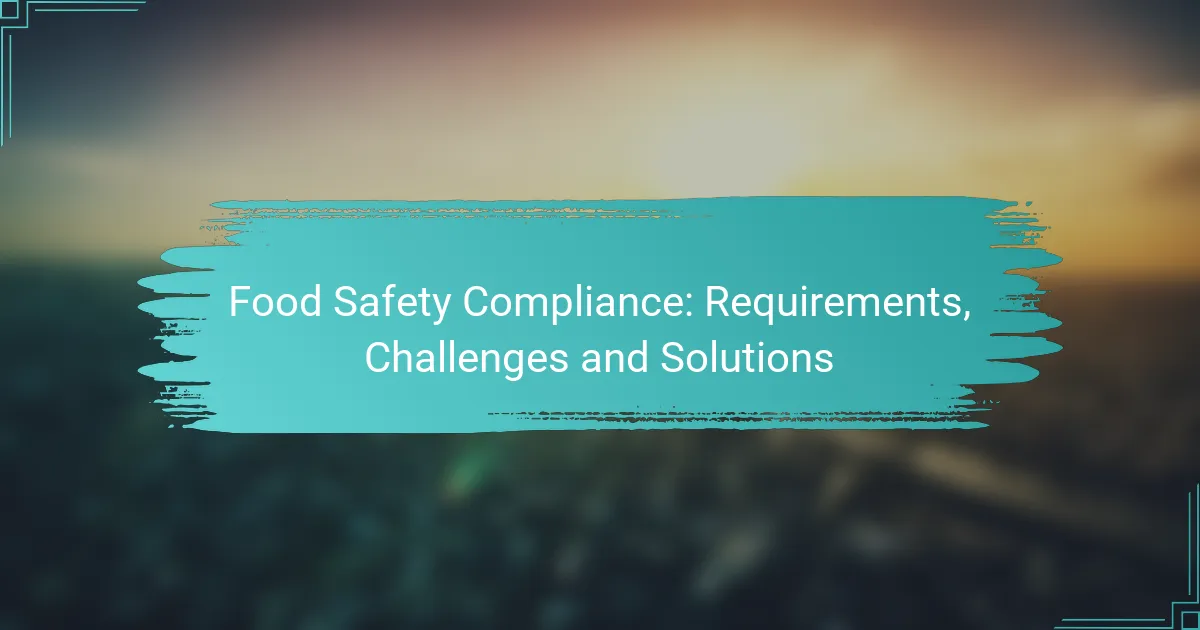Food safety compliance is crucial for protecting public health and involves adhering to regulations established by federal and state agencies. Key challenges include resource limitations and the need for ongoing staff training, which can complicate adherence to evolving guidelines. To overcome these obstacles, businesses can implement systematic training, conduct regular audits, and utilize compliance software to maintain high standards and minimize risks.

What are the food safety compliance requirements in the United States?
Food safety compliance in the United States involves adhering to regulations set by federal and state agencies to ensure the safety of food products. Key requirements include following guidelines from the FDA, implementing Hazard Analysis Critical Control Point (HACCP) principles, and meeting state-specific regulations.
FDA Food Safety Modernization Act
The FDA Food Safety Modernization Act (FSMA) emphasizes proactive measures to prevent food safety issues rather than reacting to them after they occur. This act requires food facilities to implement comprehensive food safety plans, conduct risk assessments, and maintain documentation to demonstrate compliance.
Facilities must also register with the FDA and renew their registration every two years. Non-compliance can lead to significant penalties, including fines and facility closures, making it essential for businesses to stay informed about FSMA requirements.
HACCP principles
HACCP principles are a systematic approach to identifying and managing food safety hazards. The seven core principles include conducting a hazard analysis, determining critical control points, establishing critical limits, and implementing monitoring procedures.
For example, a food processing plant may identify cooking temperature as a critical control point to eliminate pathogens. Regular monitoring and documentation of this process help ensure compliance and enhance food safety.
State-specific regulations
In addition to federal regulations, each state has its own food safety laws that may impose additional requirements. These can include specific licensing, inspection protocols, and labeling requirements that vary significantly across states.
Businesses must familiarize themselves with their state’s regulations to avoid legal issues. For instance, some states may require food handlers to obtain certification, while others may have unique guidelines for food storage and preparation.

What are the common challenges in food safety compliance?
Food safety compliance faces several challenges that can hinder effective implementation. Key issues include resource limitations, staff training problems, and the difficulty of keeping up with evolving regulations.
Resource limitations
Many organizations struggle with limited financial and human resources, which can impede their ability to meet food safety standards. Smaller businesses, in particular, may lack the budget to invest in necessary equipment or technology.
To address resource constraints, companies can prioritize essential compliance activities and seek partnerships or grants that support food safety initiatives. Utilizing cost-effective solutions, such as digital record-keeping, can also help streamline processes without significant expenditure.
Staff training issues
Effective food safety compliance relies heavily on well-trained staff. However, many organizations face challenges in providing adequate training due to high turnover rates or insufficient training programs.
To improve staff competency, businesses should implement regular training sessions and consider using online platforms for flexibility. Creating a culture of food safety can also enhance employee engagement and accountability.
Keeping up with regulations
Food safety regulations frequently change, making it challenging for businesses to stay compliant. Organizations must monitor local, national, and international standards, which can vary significantly.
Establishing a compliance team or designating a compliance officer can help ensure that the organization remains informed about regulatory updates. Additionally, subscribing to industry newsletters or joining professional associations can provide valuable insights into emerging food safety regulations.

How can businesses ensure food safety compliance?
Businesses can ensure food safety compliance by implementing systematic training, conducting regular audits, and utilizing compliance software. These strategies help maintain high standards and reduce the risk of violations.
Implementing training programs
Training programs are essential for educating staff about food safety practices and regulations. Regular sessions should cover topics such as proper food handling, hygiene practices, and allergen management.
Consider using a mix of online courses and hands-on training to cater to different learning styles. Aim for at least annual refreshers to keep knowledge current and reinforce best practices.
Conducting regular audits
Regular audits help identify compliance gaps and areas for improvement in food safety processes. These audits can be internal or conducted by third-party organizations to ensure objectivity.
Establish a schedule for audits, ideally quarterly or biannually, and create a checklist based on relevant regulations and industry standards. This proactive approach can prevent costly violations and enhance overall safety.
Utilizing compliance software
Compliance software streamlines the management of food safety protocols by automating documentation and tracking compliance metrics. This technology can simplify reporting and ensure that all necessary records are easily accessible.
When selecting software, look for features like real-time monitoring, customizable checklists, and integration with existing systems. Investing in such tools can save time and reduce the risk of human error in compliance efforts.

What role do technology solutions play in food safety compliance?
Technology solutions are essential for enhancing food safety compliance by providing tools for monitoring, analyzing, and tracking food products throughout the supply chain. These solutions help businesses adhere to regulations, reduce risks, and improve overall food safety practices.
Real-time monitoring systems
Real-time monitoring systems are designed to continuously track critical factors such as temperature, humidity, and contamination levels in food storage and processing environments. These systems utilize sensors and IoT technology to provide immediate alerts when conditions deviate from safe parameters, enabling swift corrective actions.
Implementing these systems can significantly reduce the risk of spoilage and foodborne illnesses. For example, a cold storage facility can use real-time monitoring to ensure that temperatures remain within the safe range of 0-4°C for perishable items.
Data analytics for risk assessment
Data analytics tools play a crucial role in assessing risks associated with food safety by analyzing historical data and identifying trends. These tools can help businesses pinpoint potential hazards, evaluate compliance with safety standards, and make informed decisions to mitigate risks.
For instance, a food manufacturer might analyze data from past inspections to identify recurring issues, allowing them to implement targeted training or process changes. Utilizing analytics can lead to a reduction in compliance-related incidents by up to 30% over time.
Traceability software
Traceability software enables businesses to track food products from farm to table, ensuring that every step in the supply chain is documented. This technology is vital for quickly identifying the source of contamination in the event of a food safety issue, thereby protecting consumers and maintaining compliance with regulations.
For example, a retailer can use traceability software to trace a batch of lettuce back to its farm within minutes, facilitating prompt recalls if necessary. Effective traceability can enhance consumer trust and reduce the financial impact of food safety incidents by minimizing recall sizes and associated costs.

What are the benefits of achieving food safety compliance?
Achieving food safety compliance offers significant advantages, including improved consumer trust and reduced liability risks. These benefits not only enhance a company’s reputation but also contribute to long-term success in the food industry.
Enhanced consumer trust
When a business complies with food safety standards, it signals to consumers that it prioritizes their health and well-being. This commitment fosters loyalty and encourages repeat purchases, as customers feel more secure consuming products from compliant companies.
To build consumer trust, businesses should clearly communicate their compliance efforts, such as certifications from recognized food safety organizations. Transparency about sourcing, handling, and preparation practices can further strengthen this trust.
Reduced liability risks
Food safety compliance minimizes the risk of legal issues arising from foodborne illnesses or contamination. By adhering to regulations, businesses can protect themselves from costly lawsuits and potential fines, which can significantly impact their financial stability.
To effectively reduce liability risks, companies should implement regular training for staff on food safety practices and conduct routine audits of their processes. Keeping thorough documentation of compliance efforts can also serve as a defense in case of disputes.
